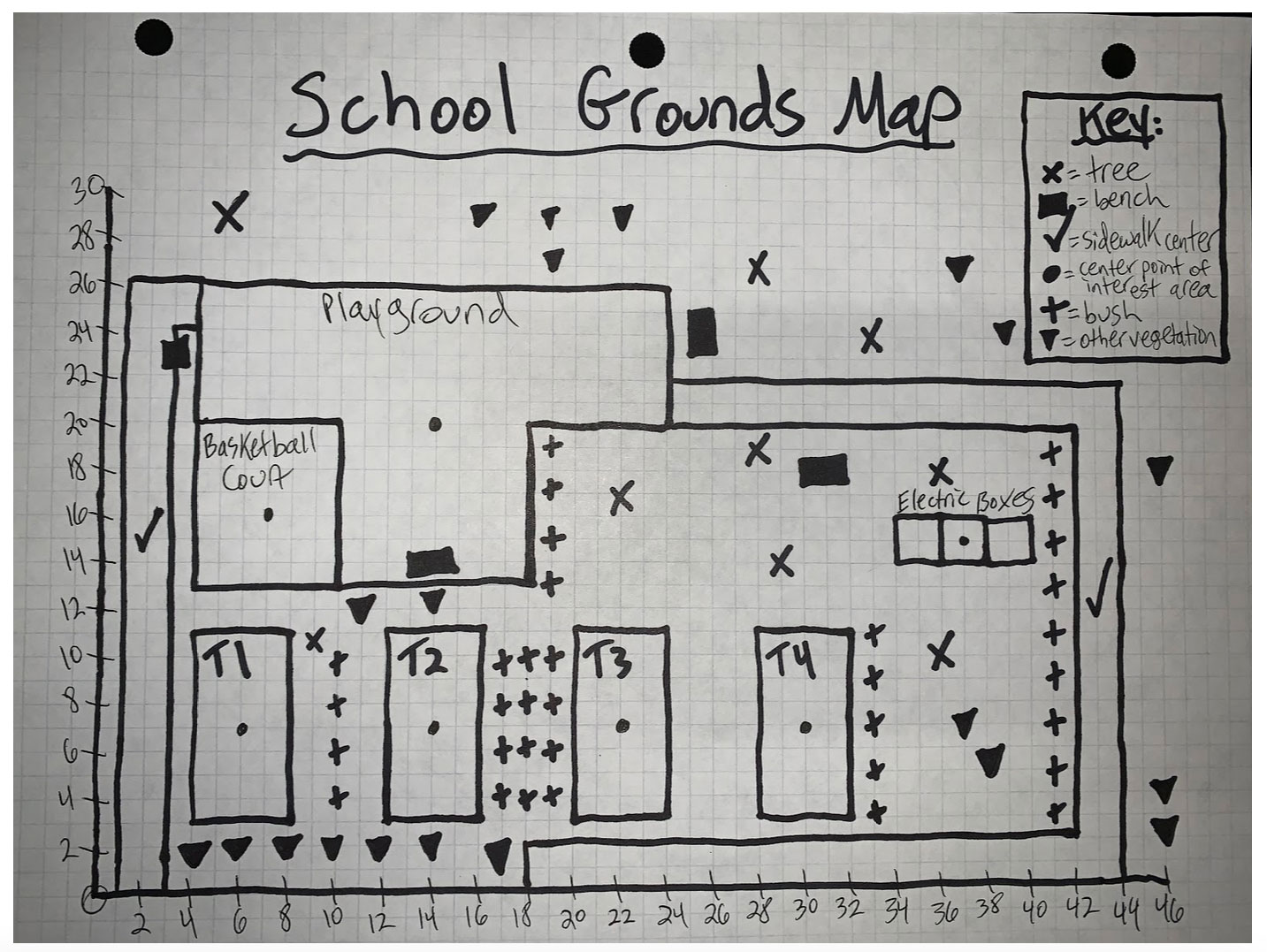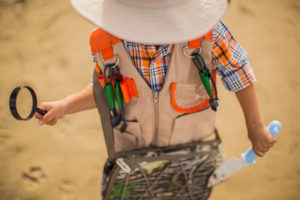Standards + Practices
Science Standards:
LS.5.2.3 Use models to infer the effects that may result from the interconnected relationship of plants and animals to their ecosystem.
Science Practices
SP2: Developing and using models
SP3: Planning and carrying out investigations
Math Standards:
NC.5.OA.3 Generate two numerical patterns using two given rules: Graph the ordered pairs on a coordinate plane.
MP4: Model with mathematics
Resources + Supports

Overarching Questions
This year, your students will serve as stewards of the ladybugs in their schoolyard to increase the number of ladybugs on the school grounds because the presence of ladybugs can indicate to us the environmental health of our school grounds.
Students will contribute data to the Lost Ladybug Project and engage in activities to figure out how many ladybugs there are currently, where they tend to be, and under what conditions. After conducting repeated searches of the school grounds for ladybugs, students will use their findings to draw conclusions about the condition of the school environment. Using ladybugs as an indicator species, students will compare their findings with those from other locations to get a sense of conditions across the state and what environments are more attractive to ladybugs than others.
The data you collect in your schoolyard and comparisons you make between your data and those of other areas in your state will help you explore these questions. We have provided support later in the year to address these questions, but it is helpful to discuss them with your students early on (and even post them in your classroom) so that they have them in mind as they participate in the Lost Ladybug Project. Note that how you collect your data may matter as you answer this question, i.e. if you have different numbers of students collecting at different times and in different locations on your school grounds every time you collect, it may impact your results. As you explore the overarching questions, it is useful to also consider how you collected your data on any given day as this will help you interpret your findings.
We encourage you to frame your data collection as a means of answering two related overarching scientific questions throughout the year:
- Species variance: Do you see differences in the types and number of ladybugs of each type that you find throughout the school year within your local area?
- Geographic variance: Do you see the same patterns across locations throughout your state?

Mr. Jones Facilitates Data Collection, In Class and Outside of School
Mr. Jones’ students are experiencing success in finding ladybugs around their school grounds; however, he notices that students are having trouble completing the Lost Ladybug Data Recording Sheet (PDF, editable form). This is making it challenging to add to their school grounds map, and Mr. Jones knows it will be problematic when later entering these data on the LLP website. Mr. Jones reminds students of the importance of consistently and accurately recording data so that it can be shared and used by others. He revisits each section of the recording sheet with students, reviewing the categories. Differentiating among some of the habitats has been particularly confusing for students, so he facilitates a discussion about the differences between the vegetation listed in the habitats section. As a class, they identify where the different types of vegetation (e.g., bushes/shrubs, woods/tree) can be found on their school grounds. Mr. Jones also reminds students that for each search, they should use a separate sheet per habitat. He provides an example from their most recent search when students found one ladybug in their school garden and one on a shrub.
Mr. Jones also anticipates that after he introduces the Lost Ladybug Project to his class, students will start finding ladybugs when not on school grounds. He wants to encourage their enthusiasm for data collection but has concerns about ensuring usable data are collected. In addition, Mr. Jones feels pressed for instructional time and wants to structure out-of-school data collection in a way that does not require additional instructional time for recording those data over the year. Mr. Jones decides that it will work best to have students record out-of-school sightings using the same data recording sheet that they use as a class. Using a ladybug he found and photographed the previous week, he models how to complete an entry in the recording sheet. Mr. Jones copies the data recording sheet that includes his example and provides each student with one. Mr. Jones then reviews how students should handle and collect/photograph ladybugs found when not at school.

Getting Started With Ladybugs
The following activities are great ways to engage student interest and motivation in the project. After completing one of these activities, you might share the Lost Ladybug brochure with your students to highlight the project’s purpose.
Name that Ladybug!
Show students the pictures of ladybugs and ask them to choose one to name. They can name them however they would like but need to provide reasoning for the name they choose. Have students share their names for each ladybug and then read the story of the 9-spotted ladybug (another version: Dylan & Jaime and the LLP) from the Lost Ladybug Website.
Can you spot the difference?
Look at the pictures of ladybugs on the slides provided and try to find what is different about each image.

Explore your school grounds
Take time with students outside simply exploring your school grounds beyond your typical perimeter. Are there rocks or logs to look under (view from 0:20-1:10 of this video to provide guidance on how to safely look under logs/rocks)? Meadow or fields to walk through? Piles of leaves? Bushes or flowers to explore? Allow students time to discover these various habitat features of your school grounds to build some background for the map you will be creating later in this month’s activity.
Have real ladybugs to observe
Prior to class, collect ladybugs from outside on your school grounds, at a park, or your home. *See extension support for more tips for collecting ladybugs and information regarding the purchasing of ladybug species from scientific supply companies

Submitting Data on the LLP Website
Data entry on the Lost Ladybug Website asks for spotter information, location, the collection date, and specific habitat information where the ladybugs were found (see screenshot 1). Additional information for data collection is optional but always helpful for data records and, whenever possible, should be included (see screenshot 2).
Use the Lost Ladybug Data Recording Sheet (PDF, editable form) as you begin to search for ladybugs. It would be helpful to start recording this information to upload it to the Lost Ladybug website during next month’s activity. It is critical that the spotter’s first and last name always be entered as the teacher’s name even if the data being reported are from observations students made at home. In future monthly activities, data from previous searches will be referenced. Having the same spotter name for all observations associated with a class will make it easier to access the data needed for data analysis activities.
Be a hero, record a zero! Students may be disappointed if they don’t find ladybugs; however, understanding the value of zeroes may encourage students to remain engaged. Zeroes are often not thought of as important data points; however, they are valuable data to scientists and should be recorded whenever possible. Without a zero, scientists would not know if an observation took place. With a zero, scientists know that an observation was made and the zero can be included as observation data.
For example, if your class has not found ladybugs while out exploring, it would still be helpful for the Lost Ladybug data collection to know this information. You would simply only fill out the first screen of the data entry, and select “no” for “Did you find any ladybugs” in the last question. Include reporting zeros as part of your data collection routine. When reporting such data it is important to indicate where and how you searched so that it is possible to use these data to evaluate the absence of ladybugs in that location.

Screenshot 1: Mandatory information, always list teacher information as spotter so that data can be easily accessed from LLP database.

Screenshot 2: The areas indicated with red boxes are most important to include as additional information.

School Grounds Map
Tips and Notes for Designing a School Grounds Map
- Create a basic outline of large structures/landmarks on a sheet of gridded chart paper (this will serve as the class map). For the student map there are two choices:
- Take a picture of the chart paper map, print in black and white, and make individual copies for each student. OR
- Recreate the outline on graph paper and make individual copies for all students.
- Note: Be sure to create a coordinate plane when using gridded chart paper for the class map and on graph paper if you are recreating the class map for the individual maps to increase the precision of data collection and provide opportunities for students to work with ordered pairs as part of NC.5.OA.3.
- Be sure the basic outline class map uses a single color. Different colors will be used later when completing ladybug searches. In the future, a particular color may be associated with each search to help track when particular ladybugs were located.
- Be sure that the map designates center points for each area that takes up significant space (sidewalk, playground, basketball court, soccer field, school buildings, etc.). Then, students can use the center point of each larger area as a reference when sharing ordered pairs.
Create a key to simplify the drawing. Symbols take up less space than entire words, freeing up more space on the coordinate plane for tracking ladybug sightings. - For each item on the key, try to include one example of its use in the basic outline that can be referenced when outdoors with students.
- When outdoors, help students make connections between what they observe and the aerial view.
- Allow students time to add points of interest and vegetation to their map.
After spending time outside, reconvene as a class and use student observations to add points of interest and vegetation to the class map.
Did you know?
Smaller areas identified in the key around the school grounds (pavement, bush, other vegetation, trees) are referred to as microhabitats by scientists.
Throughout the year, students may notice patterns in the microhabitats where ladybugs are and are not observed.

Example basic outline map

Example map with student input after spending time outside

Google Earth
In addition to the class map, consider tracking ladybugs that have been found using Google Earth. This can be done by creating a project and adding placemark features. If saved as a project, ladybug sightings can be documented throughout the school year. Here is a sample project where dates and placemark features were used to indicate when and where ladybugs were found.

Tips for Photographing Ladybugs
Finding and photographing ladybugs will require some effort to accomplish but will be key to participation in the Lost Ladybug Project. In addition, treat ladybugs with care as they are living specimens. To ensure high-quality data collection throughout the project, while maintaining ethical considerations of live specimens, review the following prior to finding and photographing ladybugs with your students.
Review the suggestions provided on the Lost Ladybug website: How to Photograph Ladybugs
What devices will your class use to photograph ladybugs? Do you have a class set of cameras? iPads? An iPhone? Will you use a clip-on magnifying lens (such as a macro lens) to take an up-close photograph? Do your students know how to use the device to take a photograph?
Ladybugs can either be photographed where found or collected to be photographed later. Photographing them on the leaf or ground where you have found them is safer for the ladybug, yet harder for the photographer. Consider what your class protocol will be for photographing and recording once a ladybug is found. For example, will you collect it in a container to photograph at a later point, or will your students take a photograph right when it is located?
- Unless collecting them to photograph later, try to avoid having students handle ladybugs.
- What tools are needed for your students to carefully and safely collect ladybugs to photograph at a later point? Do you have containers with lids to keep them in? It will be important for you to demonstrate how to safely put a ladybug into the container. Once there, where will you place the container so the ladybugs do not die? Do you have a cooler or refrigerator to keep them in until you are ready to photograph them? (Note: It is recommended that ladybugs are kept in a cooler or refrigerator no longer than a few days; in a freezer, no more than 5 minutes. Refer to the “chill out” section of the How To Find, Collect, and Photograph Guide on the Lost Ladybug website for more information regarding safely cooling the ladybugs for photographing.) Once you have finished collecting, what will be your protocols for photographing and releasing them back where students found them?
- Photographing them in the location you’ve found them is perfectly acceptable (although slightly more difficult) and safer for the ladybugs. Attempt to get as close as possible to the ladybug with your lens, rather than your hand, to try to capture a shot before it flies away. Also consider what device students will be using, and how will they record data about that photograph? It might be helpful to organize your photos by creating a folder on your desktop organized by date and habitat (location) where they were found. If using a camera, you can record the photo number on your data recording sheet to keep track of the photographs.
Will each student, or small group, have a data recording sheet to keep track of the ladybugs as they are found and where they are found, or will you have one student recording information for the whole class?
Will you enter the data immediately while outdoors, upon return to the classroom, or at a later time? It will be easy to forget to enter the data after time exploring outdoors. Be sure to have routines in place to enter the data on the website so it does not pile up.
Settings > Camera > Formats > Check “Most Compatible”
This project involves a lot of outdoor fieldwork. Therefore, consider the following list of Outdoor Protocols prior to going outside with your class. For example, specific guidelines should be established about how far a student can “follow” a ladybug. If they fly away, the ladybugs will move faster and farther than expected. Be sure to reassure students that it will be okay if they miss it or are unable to “follow” it.

Making Predictions Using School Grounds Map
Have students use the class-created school grounds map and ordered pairs to predict three spots where ladybugs will be found throughout the year after spending some time introducing the project to students. Ask students to use landmarks on the map as a reference for each prediction. Provide students feedback on their use of ordered pairs and encourage students to share the reasoning they used to make predictions.
Proficient response:
Teacher Feedback: Great job including an ordered pair and the trailer as a landmark to your point. I like how you are thinking about the habitat in your reasoning. Would your prediction be any different if the bushes were regularly cut down?
Ordered Pair Error
(see example map above):
Student Response (likely range of student responses): I predict that we will find ladybugs around (13, 38) because the ladybugs might be attracted to the electricity in the electrical boxes.
Teacher Feedback: Great job using a landmark point for your ordered pair. Check your x-axis and y-axis labels to be sure your ordered pair is correct. I like how your reasoning is thinking about how ladybugs interact with their environment.
Missing Information:
Student Response (likely range of student responses): I predict that we will find ladybugs around (18,28) because ladybugs like to be outdoors.
Teacher Feedback: What is a landmark that is nearby (18,28)? If ladybugs like to be outdoors and most of the map is an outdoor area, what made you pick (18, 28) as a likely place to find ladybugs and not other locations on the map?

Tips for Collecting Ladybugs
Tips on collecting ladybugs to hook students into the Lost Ladybug Project
- Consider finding ladybugs at home, at a park, or on your school grounds. Use a sweep net in a meadow or field, look in bushes or flowers, or under leaves on trees. See the How To Collect ladybugs section of the Lost Ladybug website. In addition, Unit 3 of the Lost Ladybug Lesson Plans (Grades 3-6) describes how to make your own sweep net.
- Keep ladybugs in a clear, closed container with small, pin-sized holes for breathing. Ladybugs can be kept cool in a cooler or refrigerator, but should not be left there for more than a few days.
Purchasing ladybugs from Scientific Supply companies could have negative environmental implications. If you have considered purchasing ladybugs for your classroom, please reflect on the following prior to purchasing:
- Research where the vendor gets their supply. Are the ladybugs native to your area? If exotic species are released, native species will be forced to compete for habitat and food.
- Ladybugs that are purchased through vendors may be vacuumed up from the wild in California during the winter and transported across the country to be delivered. These ladybugs are genetically distinct from the individuals of the same species in North Carolina and the two populations do not typically interact without human intervention.
If your class is unsuccessful finding ladybugs during your searches, feel free to jump ahead to the “Not Finding Ladybugs” Science support in the October materials.

Sightings Outside of School
Students may begin spotting ladybugs at home or outside of school time so it would be helpful to consider how they could do this safely and if their findings will be added to your class data. The following list provides questions to consider:
Will you encourage safe participation outside of school? Do all of your students have access to areas where ladybugs might be found outside of school time?
- If yes, remind students to ask for permission from their guardians first and to always consider how safe the location is to look for ladybugs.
- If no, explain to students why you would prefer they not participate outside of school.
Will students bring the ladybugs into school to record the data or will they record the data at home?
If bringing into school:
- Do students have proper collection containers?
- Do students know how to handle ladybugs carefully?
If recording data at home:
- Do students have appropriate equipment?
- Do students know all of the information needed for submission on the website (date, time, habitat, # of spotters, length of time searching, etc.)? Will they have their own data collection sheet?
- Will students upload the information themselves onto the website (and if so, do they have your login information) or wait to upload once they get to school?

In next month’s activities, students will continue collecting and photographing ladybugs and begin identifying the ones they find using a field guide. You may want to prepare copies of the Common Ladybugs of NC Field Guide for student use, as well as familiarize yourself with key anatomic characteristics of insects and the ladybug life cycle. The class will also revisit their initial predictions as they learn to identify ladybug species, so it will be helpful to have the predictions visible for students’ reflections.


 After carefully surveying your schoolyard, determine observation sites and allow students ample opportunity to explore the designated areas. As a class, create a school grounds map on chart paper to communicate where they have found ladybugs and plan subsequent search efforts.
After carefully surveying your schoolyard, determine observation sites and allow students ample opportunity to explore the designated areas. As a class, create a school grounds map on chart paper to communicate where they have found ladybugs and plan subsequent search efforts.